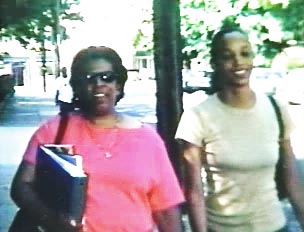Human Agency, Social Action and Classroom Practices:
What happens when teachers move over to allow students to pave their own path towards enacting change?
Vanessa
Brown
Philadelphia
Writing Project • Philadelphia, PA
with Ruba Ahmed, Desiree Pointer, and the Knowledge
Media Lab of The Carnegie Foundation
To view my video case, click on the picture above. (14 minutes, requires QuickTime Player). External speakers recommended.
This video focuses on the students and classroom practices of my ninth grade English/Language Arts classes. It grew out of the tensions that arose when my beliefs about the juxtaposition of social action and classroom practices collided with the realities of socio-economic status, personal agency, social and emotional stability and student choice and voice. Through the stories of three urban high school youth who actually represent hundreds of others with similar stories, I hope to contribute to and challenge the discourse regarding critical pedagogy in urban education. I have interlaced both music and still photos in these stories to represent the dual nature of the students' lives, which is both static and shifting.
I have always taught urban special needs children or children identified as “at risk.” Many of the students that I worked with from kindergarten to twelfth grade found little direct connection to the work we did in school and relevance to community existence. While most them could articulate that getting a good education meant getting a good job, there were few observable behaviors that reflected a true belief in that theory. Consequently, I have intentionally tried to infuse ideas about personal and community change in the English Language Arts curriculum in my classes at G-Town.
Armed with
a social action agenda, I entered my classes in 1993 ready to show students
the way to use educational as a springboard into social action. I was
going to give them purpose, motivation, information, expertise and authentic
experiences, or so I thought ....
Related
Work
My thinking was informed in part by the works of Paulo Freire, Arnetha Ball, Cynthia Ballenger, bell hooks, Linda Christensen, Sonia Nieto, Gloria Ladson Billings, James Baldwin, Schoenbach et al, Lucy Calkens and members of Project SOULL (the Study of Urban Learning and Leading), an inquiry group at the University of Pennsylvania and 28 years of teaching in Philadelphia public schools.
Context: Germantown High School in Philadelphia, Pennsylvania is the context of my work, although my thinking has spanned five schools in four different parts of the city over a twenty-eight year career. I have worked at G-town High School since 1993. Since joining the staff, I have taught adapted English/Language Arts, world history, American history and a School to Career course for which I designed an entire curriculum. This website focuses on work I did with students in my English/Language Arts classes.
Building Community: Where to Start? Class after class had entered my room and accepted with little protest the idea that we were a teaching and learning community, until....
Case Narratives (require Acrobat Reader)
-
DJ: a poignant case of one urban high school student's foray into human agency and social action in a special education English language arts class.
-
May: a case sample of a ninth grade special education student who knew what she wanted and needed from an instructional community and was ready and willing to use social action practices to achieve it.
- Andre: Andre's story is paramount to my inquiry. It describes one student who had to carve his own way for achieving justice and social action in his life and how I as a teacher had to broaden my own interpretations and perspectives to make way for his.
This site requires Acrobat Reader and the Quicktime plugin.
Created:
11/24/03.
Last updated: 11/24/03.
